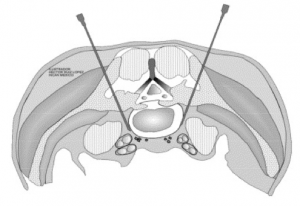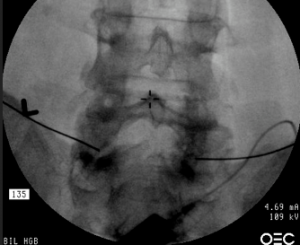Superior hypogastric plexus block injections may be an extremely effective way of reducing a patient’s pelvic pain. This may include relieving pain coming from the bladder, uterus or ovaries, prostate or testicles, lower intestines and more in the pelvis.
What exactly is a superior hypogastric plexus block?
This is an injection in the area of the superior hypogastric plexus, which is a bundle of nerves located just in front of the spinal region where the lumbar spine meets the sacrum. The superior hypogastric plexus of nerves is in front of where L5 meets S1. This plexus provides sensation to a lot of the organs and structures in the pelvis, therefore, blocking that plexus with an injection may provide significant pain relief.
Who can benefit from a superior hypogastric plexus block?
Individuals dealing with significant pelvic pain may benefit substantially as opiate medications for this type of pain often do not work very well. These injections may allow patients to get better pain relief while needing significantly less narcotic medications.
Who can benefit from a superior hypogastric plexus block?
Individuals dealing with significant pelvic pain may benefit substantially as opiate medications for this type of pain often do not work very well. These injections may allow patients to get better pain relief while needing significantly less narcotic medications.

Those suffering from gynecological pain such as from endometriosis, adhesions or chronic inflammation may benefit tremendously. In addition to these, patients may benefit who are suffering from irritable bowel syndrome, interstitial cystitis or chronic pain after a surgery such as a prostatectomy. So it is not only females who may benefit from a superior hypogastric plexus block, but also males with pelvic pain.
How is the superior hypogastric block performed?
This procedure is performed as an outpatient and the patient is placed in the prone position, which means on his or her stomach. Commonly the patient receives IV sedation for a hypogastric plexus block, but it is not actually necessary. The block can be performed simply under local medicine.
The Arizona pain clinic doctor performs the injection using a fluoroscopy machine, which is a real-time form of x-ray. This allows for the greatest accuracy when performing the procedure. Typically the pain management doctor uses two needles for the procedure. This way both sides of the hypogastric plexus can be reached with the pain medication. Once the needles are determined to be in an accurate position close to the plexus, contrast dye is injected to ensure placement is safe, then numbing medicine such as lidocaine is injected into the area. Typically along with it, cortisone is injected as well in an attempt to provide longer lasting pain relief. Instead of cortisone some pain management doctors will use phenol in an effort to deaden the nerves in the plexus.
The procedure typically takes between 30 and 45 minutes, and afterwards patients are able to go home after a short period of monitoring for stable vital signs.
Call (602) 507 – 6550 to schedule your Appointment TODAY!

How well do superior hypogastric plexus block injections work?
Hypogastric plexus blocks typically work well for a lot of individuals. Studies have shown that overall approximately there is a 50% reduction in pain and a 40% reduction in narcotic medication needs that lasts approximately one month (Schmidt et al, Rev Bras Anestesiol 2005). Looking at the overall success rate, it is approximately 70% (de Leon-Casasola et al, Pain 1992).

Superior Hypogastric Plexus Block Procedure
It is encouraging that the injection imay dramatically help individuals while maintaining a low risk profile. If the initial injection works well and then wears off after a month or so, it may be repeated every few months with the expectation that it will continue to work well on repeat injections. It should be noted that while most individuals end up with approximately a month or so of pain relief, there are plenty of others who benefit from a hypogastric block for years.
What are the risks of a hypogastric plexus block?
The risks of these injections are similar to those of other outpatient procedures. These include a risk of infection, bleeding, nerve injury, anesthesia complication, or slight cortisone side effects. An extremely rare risk is large vessel puncture. These specific risks should be discussed with your pain doctor prior to the procedure.
What’s the bottom line with a superior hypogastric plexus block?

X-ray of Superior Hypogastric Plexus Block Procedure – The dark lines are the injection catheters.
These blocks may effectively treat pelvic pain that is extremely bothersome to patients and not extremely responsive to opiate medications. It is important to make sure that your doctor has considerable expertise in these injections since the needles are placed into a delicate area. The pain management doctors at Arizona Pain Specialists are experts in superior hypogastric plexus blocks.
If you are experiencing pelvic pain from any number of conditions including endometriosis, scar tissue also known as adhesions, post surgery pain, irritable bowel syndrome, chronic inflammation, interstitial cystitis and more, call Arizona Pain today.
Call (602) 507 – 6550 to schedule your Appointment TODAY!

![]()





